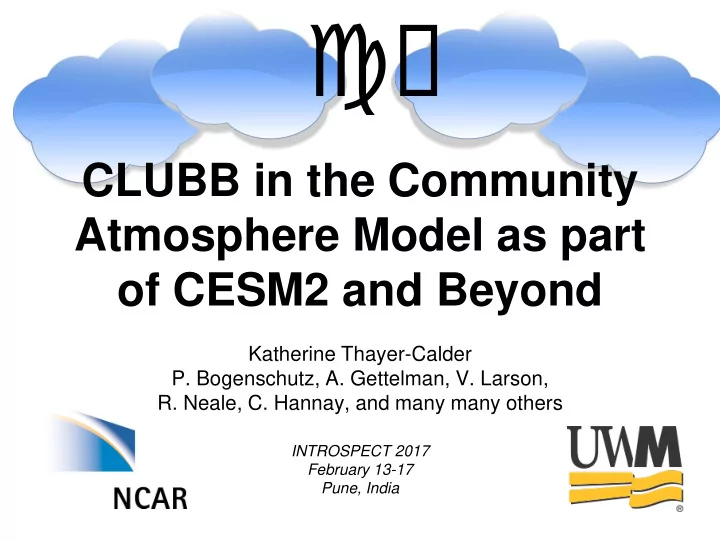

CLUBB in the Community Atmosphere Model as part of CESM2 and Beyond Katherine Thayer-Calder P. Bogenschutz, A. Gettelman, V. Larson, R. Neale, C. Hannay, and many many others INTROSPECT 2017 February 13-17 Pune, India
Overview • What is CLUBB? How is it used in CAM6 and CESM2? • Recent encouraging results from coupled simulations • CLUBB as a fully unified convective parameterization in CAM7?
What is CLUBB? • CLUBB = Cloud Layers Unified By Binormals • First developed by Golaz et al. (2002), Larson and Golaz (2003), maintained by University of Wisconsin Milwaukee (Vincent Larson’s group) ➡ Higher Order Closure Parameterizations • The equations used in convective parameterizations require information about the sub-grid fluxes of heat, moisture, and (often) momentum. Diagnosing these fluxes is a major goal of most cloud models. • Rather than making assumptions to diagnose the terms, HOC parameterizations predict (prognose) these fluxes directly. • CLUBB is an “Incomplete” third-order turbulence closure (predicting 9 second and third order moments), centered around a trivariate assumed double gaussian (binormal) PDF.
Classic Cloud Parameterizations V. Larson, “CLUBB: How it works”, AMWG Feb 2015
CLUBB Model Description convective memory V. Larson, “CLUBB: How it works”, AMWG Feb 2015
CLUBB Model Description V. Larson, “CLUBB: How it works”, AMWG Feb 2015
CLUBB Model Description V. Larson, “CLUBB: How it works”, AMWG Feb 2015
CLUBB Model Description
CLUBB Model Description r’w’ 2 r’w’ Tot Water Mixing Ratio Vert Velocity
CLUBB Model Description Cloud Fraction Saturation Tot Water Mixing Ratio Temperature
CLUBB Model Description • Length scale contributes to scale insensitivity Eddy Length Scale Characteristic Velocity
HOC vs Bulk Mass Flux
CLUBB Pros • Prognostic terms for variances allows for better cloud “memory” across time steps. • General moist turbulence parameterization can be used for many different cloud types (shallow, stratiform and PBL in CAM6). Using a single cloud and microphysical parameterizations allows for a unified representation of aerosols across many cloud types . • Constant turbulent mixing rather than undilute plumes triggered by unrealistic closures. • HOC parameterizations make no assumptions about the size of turbulence relative to the grid, and can be considered “scale insensitive.” • Higher order terms can be used by other parameterizations such as microphysics or compared to cloud model or real-world variability.
CLUBB Cons • Significantly more expensive than classic parameterizations with only diagnostic terms or a single prognostic variable. • Very complicated equation set that is not obvious in its relationship to clouds. • Possibly excessive number of tunable parameters ? Not exactly “plug-n-play.” • Trouble with precipitation and how it interacts with the PDFs of cloudy layers.
Subgrid Scale CAM Rich Neale, Breckenridge 2016
Subgrid Scale CAM Rich Neale, Breckenridge 2016
CAM6 in CESM2 LENS vs 125 Series Summary • Metric mean improved bias and RMSE • Largest improvements in tropical precipitation (3,4), SWCF (1) and Pacific surface stress (6) • Surface pressure field (0) degrading slightly (mostly variance) Slide courtesy of Rich Neale
CAM6 in CESM2 Pre-industrial SST bias (Annual) CESM2 CESM1 (LENS) Slide courtesy of Rich Neale
Precipitation bias (Annual) Obs. (GPCP) CESM2 CESM1 (LENS) Slide courtesy of Rich Neale
CAM6 in CESM2 Annual Mean Precipitation (mm/day) -Reduced double ITCZ CESM2 Obs. (GPCP) CESM1 (LENS) Obs. (GPCP) Slide courtesy of Rich Neale Slide courtesy of Rich Neale
Wavenumber Frequency Spectra • 10N-10S averaged • 20-100-day band pass filtered • MJO wave#1-3 and 30d-90d range Precipitation-flow coupling • Slide courtesy of Rich Neale Precipitation Westward Eastward 850-mb zonal wind
Slide courtesy of Rich Neale Precipitation 850-mb U • Lag correlation with Indian-Ocean precip • 20-100day band pass filter, 10S-10N Precipitation OLR • 9 years, DJFMAM
Diurnal Cycle of Precipitation (DJF) • Phase (color) and amplitude (hue) • Too early over land on average • ~8 hours too early in CESM1 ~4 hours too early in CESM2 • • Over Ocean amplitude too weak (timing good) Slide courtesy of Rich Neale
CLUBB and Deep Convection • Typically hard for HOC parameterizations to do deep convection because there is no imbedded microphysics. • Need a way to tightly couple the HOC CLUBB scheme to a microphysics scheme…. Subcolumns!
What are Subcolumns? • A second dimension for grid columns in CAM • A data structure that represents the model state within a GCM grid column • Subcolumns have the same vertical resolution as the larger grid
The Benefits of Unified Convection and Unified Microphysics in CAM Consistent treatment of clouds around the planet Simplifies budgets and tuning to a single tendency and parameter set Ability to simulate aerosol effects in all cloud types Theoretically scale insensitive convection makes increasing resolution easier More physically realistic
CAM-CLUBB-SILHS Thayer-Calder et al. 2015
CAM-CLUBB-SILHS Thayer-Calder et al. 2015
CAM-CLUBB-SILHS Thayer-Calder et al. 2015
CAM-CLUBB-SILHS Thayer-Calder et al. 2015
CAM-CLUBB-SILHS
CAM- CLUBB- SILHS Thayer-Calder et al., 2015 Thayer-Calder and Randall, 2009
CAM-CLUBB- SILHS ne30 (1 deg) vs ne120 (28 km) Cloud Fraction Simulations by Pete Bogenschutz
Simulations by ne30 vs ne120 Pete Bogenschutz LWCF SWCF
ne30 vs ne120 Simulations by Pete Bogenschutz Precip
Conclusions • CLUBB is a Higher Order Closure Parameterization with a general mathematic framework for calculating moisture and temperature tendencies due to moist turbulence and convection. • CLUBB integrates over a multi-variate binormal PDF to close higher order terms. • CLUBB is expensive and complicated but includes scale awareness, convective memory, and the ability to simulate many cloud types with a single equation set.
Recommend
More recommend